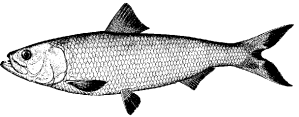By Meg Jones of the Journal Sentinel
 It's the Walking Dead, alewives-style.
It's the Walking Dead, alewives-style.
Looking like eyeless zombies strewn across the sandy landscape, alewives are dying in droves and washing ashore on some Lake Michigan beaches in the Milwaukee area.
Depending on weather conditions and wind direction, the odor has ranged from a slight fishy smell with a soupçon of algae to "Oh my gosh, what is that?"
It happens every year when alewives, deep-water creatures, come close to shore to spawn.
If the water temperature changes quickly, alewives die off. Some years are worse than others.
And this year — at least anecdotally — appears to be one of them.
"I've never seen it this bad in the three years I've been sampling beaches," said Danielle Cloutier, a graduate student at the University of Wisconsin-Milwaukee School of Freshwater Sciences.
While the current die-off is nowhere near the massive malodorous blots of the 1960s and '70s, when bulldozers and trucks were used to get rid of dead alewives, several beaches in southeastern Wisconsin are ringed with dull silver, stinky necklaces of piled-up alewives.
Looking like a sardine on steroids, alewives are not native to the Great Lakes. They're actually ocean fish that somehow found their way here in the 1920s and '30s.
"They're able to live in the Great Lakes but it's not ideal for them," said Titus Seilheimer, a fisheries specialist for the University of Wisconsin Sea Grant Institute in Madison. "They get a little stressed physiologically. That tends to make them more sensitive to sudden changes in water temperatures."
Alewives prefer deep, cold water but move into shallow areas during spawning in late spring and early summer.
Because shallow water can quickly warm up at this time of year, sometimes it gets too warm and alewives end up belly up.
A U.S. Geological Services temperature sensor at the mouth of the Milwaukee River where it flows into Lake Michigan showed the surface water temperature was 65 degrees Monday afternoon. That's around five degrees warmer than a week ago. It's much colder farther out in Lake Michigan.
Harvey Bootsma, associate professor in UWM's School of Fresh Water Sciences, noticed that alewives, members of the herring family, didn't seem to weather the winter well.
That could be because they are competing for food with another invasive species, quagga mussels. Both species dine on phytoplankton.
"When we were diving last week we saw a lot of alewives but they looked skinny. So they're not getting enough to eat," said Bootsma, who also saw lots of alewives in the Milwaukee harbor and the nearshore area during surveys by boat.
Not all creatures are sad to see alewives die — gulls are feasting on them like an all-you-can-eat buffet.
At Atwater Beach in Shorewood, alewife carcasses conjoined with flotsam comprised of twigs, gull feathers, plastic bottle caps, wine bottle corks, unidentified pieces of plastic and other stuff embedded in the sand turned the water the color of Earl Grey tea.
On a recent afternoon, a flock of gulls stood near the water's edge, a few picking at the rotting corpses.
At one time, half a century ago, Lake Michigan was filled with alewives. When they first arrived in the Great Lakes, they had few predators so when they came close to land to procreate and the water temperature changed too quickly, waves of them washed ashore. Then fisheries biologists introduced chinook and coho salmon to boost sportfishing and act as a check on alewives.
The salmon, particularly chinook, did their jobs very well.
"They helped to keep numbers down. But in the last decade alewives numbers have dropped lower along with smelt but we think that's due to quagga mussels eating a lot of plankton so there's fewer food sources," Bootsma said.
While the sight of fish carcasses might not be appetizing while picnicking at the beach, there's no danger to beach-goers. Cloutier and others sample water and sand at several beaches in the Milwaukee area every week; as long as the beach is open and signs say it's OK to swim, there really isn't anything to worry about, Cloutier said.
Carmen and Rafael Vazquez visited the lakeshore Monday afternoon, walking along the beach just north of McKinley Marina with their two daughters and their dog, Chewie, a Bichon Frise/Shih Tzu mix. Naturally, Chewie was the first to notice the dead alewives. The inquisitive white pup sniffed at them and then, since a pile of dead fish is like catnip to dogs, jumped in and rolled in them.
"I was kind of curious — what happened?" said Rafael Vazquez, looking at the dead slivers of silver.
Carmen Vazquez moved to Milwaukee 21 years ago and is used to alewife die-offs. "The smell isn't that bad, it's been worse."
As Chewie cavorted on the beach, the Vazquez family said he would get a bath when they got home.
http://www.jsonline.com/news/milwaukee/not-as-bad-as-the-70s-but-alewives-are-piling-up-on-the-beaches-again-b99297596z1-264377911.html

